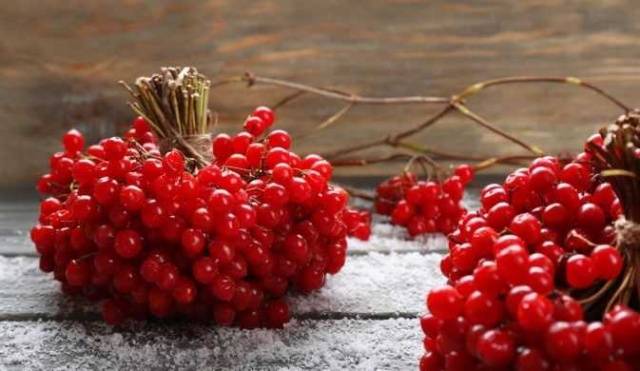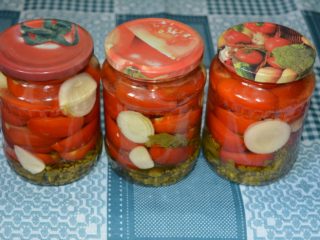Our ancestors considered viburnum to be an almost mystical plant, capable of protecting the house from evil spirits with its presence. Its symbolism for the Slavic peoples is very interesting, ambiguous and worthy of careful study. But according to all beliefs, viburnum does not have negative qualities, but mainly brings protection or consolation.
This is a tasty and very healthy berry. Most often, viburnum is simply collected, the umbrellas are tied into bundles, and then hung out to dry. Meanwhile, you can make excellent jams from it, jam, candies, compotes, jellies and many other sweet delicacies. The berries are frozen and used as a filling for pies, raw materials for wine or liqueurs. Today we will tell you how to prepare viburnum with sugar for the winter.
Properties of viburnum
The beneficial properties of viburnum have been well known for a long time. It can help us out, acting as an adjuvant in the treatment of many diseases.
Healing properties
Viburnum is rich in organic acids and contains many minerals, including chromium, iodine, selenium, vitamins A, E, P, K, C (70% more than in lemons).It contains tannins and essential substances, pectins, coumarins, tannin, and viburnin.
Viburnum berries have many beneficial properties; they are used:
- for cardiovascular disorders, hypertension, atherosclerosis;
- for gastrointestinal diseases;
- for colds and coughs;
- with uterine bleeding, menopause;
- to normalize sugar and cholesterol levels;
- for nervous disorders, insomnia;
- to remove excess fluid from the body and relieve swelling.
They have a pronounced antiseptic, antispasmodic, expectorant, antipyretic, anti-inflammatory, sedative and diaphoretic effect.
When viburnum is harmful
Viburnum contains so many useful substances that it is simply impossible to eat it in exorbitant quantities. An overdose of vitamin C, for example, will cause itching and rashes. There are direct contraindications that require completely excluding it from the diet:
- pregnancy;
- hypotension (low blood pressure);
- increased blood clotting;
- gout.
Naturally, viburnum with sugar is contraindicated for diabetics.
Viburnum preparations with sugar
When we prepare viburnum for the winter, we try to ensure that it retains maximum beneficial properties and is tasty. Usually the berries ripen in September, but the bitterness makes them not a very pleasant delicacy. When harvesting, it is better to wait until the first frost, and then carefully cut off the umbrellas with scissors.
Fresh viburnum preparations
If you prepare viburnum without heat treatment, it will retain more beneficial properties.
Grinded with honey
Take a kilogram of viburnum berries, wash them under running water, and pour boiling water over them. Then, using a wooden masher, press the berries through a fine sieve. Measure the volume of the resulting fruit puree, add the same amount of honey to it.Mix thoroughly, place in clean jars, and put in the refrigerator.
After 10 days, viburnum, ground with honey, is ready. It's hard to tell if you made it a medicine or a treat. Probably, if you have a lot of honey and you have prepared several jars, this is jam. One, lurking forlornly in the corner of the refrigerator, turns into a magic potion for a cold or bad mood.
Grinded with sugar
Just like with honey, you can prepare viburnum, pureed with sugar. But if bitterness doesn’t bother you, it’s better to puree the berries, peel and seeds, in a blender. Then combine viburnum with sugar 1:1, mix well, place in jars, and seal with nylon or screw caps. Leave for 2-3 days in a warm place so that the sugar melts a little, put in the refrigerator.
This cooking method has several advantages:
- You will get more raw jam;
- it will be much more useful, since most of the useful substances are in the peel, which usually remains on the seeds or sieve;
- Thanks to the bitterness contained in the seeds, you won’t eat all the jam at once.
Covered with sugar
This method is designed specifically for lazy people. Take equal volumes of viburnum and sugar. Wash the berries and dry with a paper towel. Place a layer of sugar about 1-1.5 cm on the bottom of the jar, and the same volume of viburnum on top. Gently tap the bottom of the container on the table. Then again add layers of sugar and viburnum. Repeat this algorithm until you fill the entire jar. The last layer should be a layer of sugar.
Place the jar in the refrigerator.When you want tea with viburnum, pour 2-3 tablespoons into a cup and pour boiling water over it. Even if the sugar hardens, it doesn’t matter; it won’t affect the taste or beneficial properties. It will just be difficult for you to get viburnum from a jar.
Candied berries
For 1 kg of berries you need 200 g of powdered sugar, 5 g of starch.
Wash the viburnum. Mix starch with powdered sugar in a dry bowl or saucepan, add berries there, shake the bowl thoroughly.
Cover the baking sheet with parchment paper.
Place viburnum berries coated with powdered sugar and starch on a baking sheet in a layer no thicker than 1 cm.
Dry at room temperature for 15 hours, then pour into clean, dry jars, close with nylon lids, and store in a cool place.
Workpieces using heat treatment
Of course, some vitamins are lost during pasteurization or boiling. But what should those who do not have a basement or cellar do, whose refrigerator is already full, and then luck strikes - a large amount of viburnum appears from somewhere? Of course, you can dry everything. But why? You can make so many delicious things from viburnum!
A simple recipe with minimal heat treatment
For 1 kg of viburnum berries, take the same amount of sugar if the jam is made from only pulp, or 1.5 kg for a preparation with seeds.
Rinse the berries, pour boiling water over them and leave for 5 minutes.
Drain the water completely, pour the viburnum into a container for making jam and add sugar. Using a wooden masher, mash the mixture well and place on low heat.
Stir the jam constantly; when it boils, all the sugar should dissolve.
If you are not going to remove the viburnum seeds, boil the mixture for 5 minutes, place in sterile jars and seal tightly.
If you are preparing jam from one pulp, immediately after boiling, remove the container from the heat and rub its contents through a sieve. Return the puree to the heat, let it boil, put it in sterile jars, and roll it up.
Viburnum jelly
For 1 kg of viburnum, take 1 kg of sugar and 0.5 liters of water.
Wash the berries, place them in a saucepan and pour boiling water over them for 5 minutes. Place the viburnum on a sieve, strain out the water and rub it with a wooden pestle, separating the pulp from the seeds.
Pour the berry puree into a saucepan for making jam, add water and sugar, stir well. Place on low heat.
When the viburnum, ground with sugar, boils, cook, stirring constantly for another 40 minutes.
Pour the jelly into sterile jars and roll up.
Berry marshmallow
Oddly enough, this recipe is very close to real marshmallows, the recipe for which was given in Domostroy. For 1 kg of berries, take the same amount of sugar and 250 ml of water.
Pour boiling water over the washed viburnum for 5 minutes, drain.
Place the berries in a saucepan, add water, and cook over low heat until they soften.
Rub the viburnum together with the liquid through a sieve.
Add sugar and simmer over low heat. When the pureed viburnum reaches the thickness of homemade sour cream, pour it onto a baking sheet lined with parchment paper.
Place in the oven and dry at a temperature of 40 to 60 degrees.
The pastille is ready when it easily comes away from the paper. Sprinkle both sides with powdered sugar, roll up and cut into spirals 0.5-1.5 cm thick. Place in a cardboard or wooden box and store in a cool place.
In sugar syrup
For 1 kg of viburnum, take 400 g of sugar and 600 ml of water.
Place clean berries in sterile jars and fill with syrup made from water and sugar. Pasteurize half-liter containers at a temperature of 80 degrees for 15 minutes, liter containers for 30. Seal hermetically.
Conclusion
These are just some of the preparations that can be made from viburnum berries. We hope you liked them. Bon appetit!




















